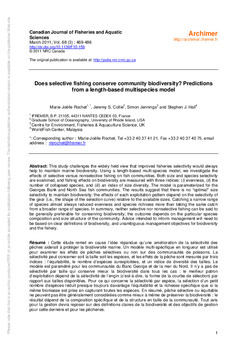Does selective fishing conserve community biodiversity? Predictions from a length-based multispecies model
Abstract
This study challenges the widely held view that improved fisheries selectivity would always help to maintain marine biodiversity. Using a length-based multi-species model, we investigate the effects of selective versus nonselective fishing on fish communities. Both size and species selectivity are examined, and fishing effects on biodiversity are measured with three indices: (i) evenness, (ii) the number of collapsed species, and (iii) an index of size diversity. The model is parameterized for the Georges Bank and North Sea fish communities. The results suggest that there is no “optimal” size selectivity to maintain biodiversity: the effects of each exploitation pattern depend on the selectivity of the gear (i.e., the shape of the selection curve) relative to the available sizes. Catching a narrow range of species almost always reduced evenness and species richness more than taking the same catch from a broader range of species. In summary, neither selective nor nonselective fishing can be said to be generally preferable for conserving biodiversity; the outcome depends on the particular species composition and size structure of the community. Advice intended to inform management will need to be based on clear definitions of biodiversity, and unambiguous management objectives for biodiversity and the fishery

